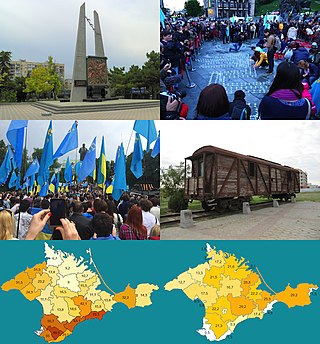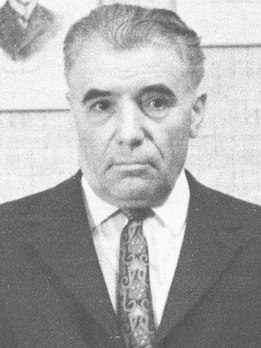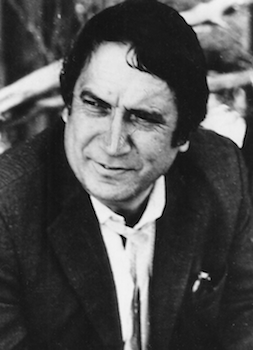Related Research Articles

Crimean Tatars or Crimeans are a Turkic ethnic group and nation indigenous to Crimea. The formation and ethnogenesis of Crimean Tatars occurred during the 13th–17th centuries, uniting Cumans, who appeared in Crimea in the 10th century, with other peoples who had inhabited Crimea since ancient times and gradually underwent Tatarization, including Ukrainian Greeks, Italians, Ottoman Turks, Goths, Sarmatians and many others.

The deportation of the Crimean Tatars or the Sürgünlik ('exile') was the ethnic cleansing and the cultural genocide of at least 191,044 Crimean Tatars that was carried out by Soviet Union authorities from 18 to 20 May 1944, supervised by Lavrentiy Beria, chief of Soviet state security and the secret police, and ordered by the Soviet leader Joseph Stalin. Within those three days, the NKVD used cattle trains to deport the Crimean Tatars, even Soviet Communist Party members and Red Army members, from Crimea to the Uzbek SSR, several thousand kilometres away. They were one of several ethnicities that were subjected to Stalin's policy of population transfer in the Soviet Union.

Musa Mamut was a deported Crimean Tatar who immolated himself in Crimea as a sign of protest against the enforced exile of indigenous Crimean Tatars. His self-immolation symbolized the Crimean Tatar belief that deportation back to exile was worse than death. Today, he remains an icon of the Crimean Tatar civil rights movement. His act of ultimate self-sacrifice was later repeated by other Crimean Tatars, but Mamut remains the most well-known Crimean self-immolator, with his act being commemorated annually with large memorials. Crimean Tatar literature often describes him as an eternal flame illuminating Crimea.

Yuri Bekirovich Osmanov was a scientist, engineer, Marxist–Leninist, and Crimean Tatar civil rights activist. He was one of the co-founders of the National Movement of Crimean Tatars, which sought full right of return of the Crimean Tatar people to their homeland and restoration of the Crimean ASSR.
Tatarophobia refers to the fear of, the hatred towards, the demonization of, or the prejudice against people who are generally referred to as Tatars, including but not limited to Volga, Siberian, and Crimean Tatars, although negative attitudes against the latter are by far the most severe, largely as a result of the Soviet media's long-standing practice of only depicting them in a negative way along with its practice of promoting negative stereotypes of them in order to provide a political justification for the deportation and marginalization of them.
Ayşe Seitmuratova is a Crimean Tatar civil rights activist.

The de-Tatarization of Crimea refers to the Soviet and Russian efforts to remove traces of the indigenous Crimean Tatar presence from the peninsula. De-Tatarization has been manifested in various ways throughout history, ranging from the full-scale deportation and exile of Crimean Tatars in 1944 to other measures such as the burning of Crimean Tatar books published in the 1920s and toponym renaming.

Şamil Alâdin was a Crimean Tatar writer, poet, translator, and civil rights activist. Early in his career he wrote poetry, later moving on to prose and nonfiction works.
The Letter of Seventeen was a highly controversial open letter published in Lenin Bayrağı in March 1968, condemning the desire for the right of return among the exiled Crimean Tatar community. It was often referred to as "the letter of seventeen traitors."

Rollan Kemalevich Kadyev was a Crimean Tatar physicist and civil rights activist in the Soviet Union. A defendant in the Tashkent process, he became known as a firebrand opponent of marginalization and delimination Crimean Tatars, publicly denouncing the restrictions on returning to Crimea as well as the government policy of claiming Crimean Tatars were not a distinct ethnic group that was exemplified by official use of the euphemism "people of Tatar nationality who formerly lived in the Crimea" instead of their proper ethnonym of "Crimean Tatar". For his activities such as distributing leaflets and verbally confronting those who endorsed the status quo against of national policy relating the Crimean Tatars, he was imprisoned on charges of "defaming the Soviet system", despite passionately making the case that discriminatory and assimilationist policies against Crimean Tatars was a huge deviation from proper Leninist national policy. Later on in his life he significantly softened his tone after a 1979 imprisonment for getting into a fight with a party organizer, controversially signing off an open letter critical of Ayshe Seitmuratova's activities with Radio Liberty, which was published in Lenin Bayrağı and Pravda Vostoka in February 1981.
Decree No. 493 "On citizens of Tatar nationality, formerly living in the Crimea" was issued by the Presidium of the Supreme Soviet on 5 September 1967 proclaiming that "Citizens of Tatar nationality formerly living in the Crimea" [sic] were officially legally rehabilitated and had "taken root" in places of residence. For many years the government claimed that the decree "settled" the "Tatar problem", despite the fact that it did not restore the rights of Crimean Tatars and formally made clear that they were no longer recognized as a distinct ethnic group.

Dzhebbar Akimov was a Crimean Tatar teacher, writer who worked as editor of the newspaper "Qızıl Qırım" until the Sürgün. In exile, stood at the origins of the Crimean Tatar rights movement, becoming the leader of the Bekabad initiative group as well as authoring many documents about their plight for which he was expelled from the party in 1966, dubbed "the most active supporter of returning to Crimea" by the government in 1967, and eventually sentenced to three years in prison in 1972. Like many other leaders of the original Crimean Tatar rights movement, he considered himself a communist and opposed the prospect of members of movement associating with Soviet dissidents like Andrey Sakharov and Pyotr Grigorenko.
The Tashkent Ten were ten Crimean Tatar civil rights activists tried in Tashkent by the Uzbek Supreme Court from 1 July to 5 August 1969. The trial was sometimes called the Tashkent Process.
The National Division of Crimean Tatars is a Crimean Tatar civil rights organization that was highly active in the late Soviet era.
The OKND was an anti-communist grouping of Crimean Tatars and the successor of the Central Initiative Group in the late Soviet era. It was formed in opposition to the Leninist NDKT.

The Gromyko Commission, officially titled the State Commission for Consideration of Issues Raised in Applications of Citizens of the USSR from Among the Crimean Tatars was the first state commission on the subject of addressing what the dubbed "the Tatar problem". Formed in July 1987 and led by Andrey Gromyko, it issued a conclusion in June 1988 rejecting all major demands of Crimean Tatar civil rights activists ranging from right of return to restoration of the Crimean ASSR.
The main wave of Crimean Tatar repatriation occurred in the late 1980s and early 1990s when over 200,000 Crimean Tatars left Central Asia to return to Crimea whence they had been deported in 1944. While the Soviet government attempted to stifle mass return efforts for decades by denying them residence permits in Crimea or even recognition as a distinct ethnic group, activists continued to petition for the right of return. Eventually a series of commissions were created to publicly evaluate the prospects of allowing return, the first being the notorious Gromyko commission that lasted from 1987 to 1988 that issued declaring that "there was no basis" to allow exiled Crimean Tatars to return en masse to Crimea or restore the Crimean ASSR.
Crimean Tatar denialism is the idea that the Crimean Tatars are not a distinct ethnic group. After the deportation of the Crimean Tatars, the Soviet government no longer recognized Crimean Tatars as a distinct ethnic group and forbade internal passports and official documents from using the term in the nationality section despite previously permitting it. The non-recognition of Crimean Tatars was emphasized by the wording of Ukaz 493, which used the euphemism "Citizens of Tatar nationality formerly living in Crimea." Only in 1989 were all restrictions on the use of the term lifted.
Mubarek zone was the name given to a Soviet-Uzbek project to promote Crimean Tatar settlement into the newly formed Mubarek District of the Uzbek SSR, instead of allowing for a return to their homeland in the Crimea. The project was very unpopular with Crimean Tatars, who wanted to return to Crimea instead of settling into the Uzbek desert. Many viewed the project as an extension of the wider Uzbek cotton scandal. The Mubarek District was established in 1978, and the whole settlement project was largely abandoned after the death of its mastermind, Sharof Rashidov in 1983.
Timur Şahmurad oğlu Daĝcı was a Crimean Tatar journalist and newspaper editor. In his youth he was involved in the Crimean Tatar rights movement, but later became active in the Communist Party and actively promoted the Mubarek resettlement scheme intended to resettle Crimean Tatars in the Uzbek desert.
References
- ↑ Williams 2021, p. 337.
- ↑ Uehling 2004, p. 259.
- ↑ Guboglo 1992.
- ↑ Fisher 2014, p. 250-252.
- 1 2 Williams 2016, p. 107-108.
- ↑ Uehling 2004, p. 100.
- 1 2 Allworth 1998, p. 225-227.
- ↑ Stronski 2010, p. 133.
- 1 2 Naimark 2002, p. 67-69.
- ↑ Khayali 2016, p. 28-38.
- 1 2 Williams 2016, p. 108.
- ↑ Buckley, Ruble & Hofmann 2008, p. 213.
- ↑ Williams 2016, p. 108, 136.
- ↑ Buttino 1993, p. 68.
- ↑ Basket Three 1977, p. 261.
- ↑ Report. The Group. 1970. pp. 14–20.
- ↑ Williams 2001, p. 420.
- ↑ Allworth 1988, p. 55, 167–169.
- ↑ Uehling 2004, p. 208.
- ↑ Allworth 1988, p. 167-169.
- ↑ Gromenko 2016, p. 283-286.
- ↑ Yakupova 2009, p. 28-30, 47–48.
- ↑ Ablyazov 2015.
- ↑ Russia. Chalidze Publication. 1983. pp. 121–122.
- ↑ Биз - къырымлармыз!: Мы - крымцы! 2006, p. 33.
- ↑ Dagdzhi 2008, p. 175.
- ↑ Allworth 1998, p. 200.
- ↑ Allworth 1988, p. 344.
- ↑ Smith 1996, p. 425-426.
- ↑ Fouse 2000, p. 340.
- ↑ Mastny 2019, p. 133.
- ↑ Country Reports 1989, p. 1230.
- ↑ Human Rights Watch 1991, p. 38.
- ↑ Vyatkin 1997, p. 32.
- ↑ Bekirova 2016.
- ↑ Skutsch 2005, p. 1190.
- ↑ Arbatov, Lynn-Jones & Motley 1997, p. 96-97.
Bibliography
- Ablyazov, Emir (13 March 2015). "Герой добился права жить и умереть на Родине". goloskrimanew.ru. Archived from the original on 9 October 2019. Retrieved 9 October 2019.
- Allworth, Edward (1988). Tatars of the Crimea: Their Struggle for Survival : Original Studies from North America, Unofficial and Official Documents from Czarist and Soviet Sources. Duke University Press. ISBN 978-0-8223-0758-7.
- Allworth, Edward (1998). The Tatars of Crimea: Return to the Homeland: Studies and Documents. Duke University Press. ISBN 9780822319948.
- Arbatov, Aleksey; Lynn-Jones, Sean; Motley, Karen (1997). Managing Conflict in the Former Soviet Union: Russian and American Perspectives. MIT Press. pp. 96–97. ISBN 9780262510936. Archived from the original on 31 March 2023. Retrieved 5 October 2019.
- Aydın, Filiz Tutku (2021). Émigré, Exile, Diaspora, and Transnational Movements of the Crimean Tatars: Preserving the Eternal Flame of Crimea. Springer Nature. ISBN 978-3-030-74124-2.
- Beissinger, Mark (4 February 2002). Nationalist Mobilization and the Collapse of the Soviet State. Cambridge University Press. ISBN 978-0-521-00148-9.
- Bekirova, Gulnara (2004). Крымскотатарская проблема в СССР: 1944-1991 [Crimean Tatar problem in the USSR: 1944-1991] (in Russian). Simferopol: Odzhak Publishing House. ISBN 978-966-8535-06-2.
- Bekirova, Gulnara (2005). Крым и крымские татары в XIX-XX веках: сборник статей [Crimea and Crimean Tatars in the 19th-20th centuries: a collection of articles] (in Russian). Moscow.
{{cite book}}: CS1 maint: location missing publisher (link) - Bekirova, Gulnara (1 April 2016). "Юрий Османов". Крым.Реалии (in Russian). Archived from the original on 12 February 2019. Retrieved 13 September 2019.
- Buttino, Marco (1993). In a Collapsing Empire: Underdevelopment, Ethnic Conflicts and Nationalisms in the Soviet Union. Feltrinelli Editore. ISBN 88-07-99048-2.
- Buckley, Cynthia J.; Ruble, Blair A.; Hofmann, Erin Trouth (2008). Migration, Homeland, and Belonging in Eurasia. Woodrow Wilson Center Press. ISBN 9780801890758.
- * Dagdzhi, Timur (2008). Сталинский геноцид и этноцид крымскотатарского народа: документы, факты, комментарии [Stalin's genocide and ethnocide of the Crimean Tatar people: documents, facts, comments] (in Russian). Simferopol City Printing House.
- Fisher, Alan W. (2014). The Crimean Tatars. Hoover Press. ISBN 9780817966638. Archived from the original on 31 March 2023. Retrieved 5 October 2019.
- Fouse, Gary C. (2000). The Languages of the Former Soviet Republics: Their History and Development. University Press of America. ISBN 9780761816072. Archived from the original on 31 March 2023. Retrieved 5 October 2019.
- Gromenko, Sergey (2016). Наш Крим: неросійські історії українського півострова (in Ukrainian). Український інститут національної пам’яті. pp. 283–286. ISBN 9786176841531. Archived from the original on 31 March 2023. Retrieved 5 October 2019.
- Guboglo, Mikhail (1992). Крымскотатарское национальное движение: Документы, материалы, хроника (in Russian). Russian academy of Sciences.
- Guboglo, Mikhail (1998). Языки этнической мобилизации (in Russian). Языки русской культуры. ISBN 978-5-457-45045-5.
- Khayali, Rustem (2016). "Политико-правовое урегулирование крымско-татарской проблемы в СССР (1956-1991 гг. )". Leningradsky Yuridicheskiy Zhurnal (in Russian) (3).
- Mastny, Vojtech (2019). Soviet/east European Survey, 1987-1988: Selected Research And Analysis From Radio Free Europe/radio Liberty. Routledge. ISBN 9781000312751. Archived from the original on 31 March 2023. Retrieved 5 October 2019.
- Naimark, Norman (2002). Fires of Hatred. Harvard University Press. pp. 67–69. ISBN 9780674975828. Archived from the original on 31 March 2023. Retrieved 5 October 2019.
- Smith, Graham (1996). The nationalities question in the post-Soviet states . Longman. ISBN 9780582218086.
- Skutsch, Carl (2005). Encyclopedia of the world's minorities. Vol. 3. Routledge. ISBN 9781579584702. Archived from the original on 31 March 2023. Retrieved 5 October 2019.
- Stronski, Paul (2010). Tashkent: Forging a Soviet City, 1930–1966. University of Pittsburgh Pre. ISBN 9780822973898. Archived from the original on 31 March 2023. Retrieved 5 October 2019.
- Uehling, Greta (2004). Beyond Memory: The Crimean Tatars' Deportation and Return. Springer. ISBN 978-1-4039-8127-1.
- Vyatkin, Anatoly (1997). Крымские татары: проблемы репатриации (in Russian). Ин-т востоковедения РАН. ISBN 9785892820318. Archived from the original on 31 March 2023. Retrieved 5 October 2019.
- Williams, Brian Glyn (2001). The Crimean Tatars: The Diaspora Experience and the Forging of a Nation. Brill. ISBN 9789004121225. Archived from the original on 31 March 2023. Retrieved 5 October 2019.
- Williams, Brian (2016). The Crimean Tatars: From Soviet Genocide to Putin's Conquest. Oxford University Press. ISBN 978-0-19-049470-4.
- Williams, Brian (2021). The Crimean Tatars: The Diaspora Experience and the Forging of a Nation. BRILL. ISBN 978-90-04-49128-1.
- Yakupova, Venera (2009). Крымские татары, или Привет от Сталина! (PDF). Kazan: Часы истории. pp. 28–30, 47–48. Archived (PDF) from the original on 26 September 2019. Retrieved 5 October 2019.
- United States Congress Commission on Security and Cooperation in Europe (1977). Basket Three, Implementation of the Helsinki Accords: Religious liberty and minority rights in the Soviet Union. Helsinki compliance in Eastern Europe. U.S. Government Printing Office. p. 261. Archived from the original on 31 March 2023. Retrieved 5 October 2019.
- Country Reports on Human Rights Practices: Report Submitted to the Committee on Foreign Affairs, U.S. House of Representatives and Committee on Foreign Relations, U.S. Senate by the Department of State in Accordance with Sections 116(d) and 502B(b) of the Foreign Assistance Act of 1961, as Amended. U.S. Government Printing Office. 1989. Archived from the original on 31 March 2023. Retrieved 5 October 2019.
- Биз - къырымлармыз!: Мы - крымцы! [We are Crimeans!] (in Crimean Tatar). Aqmescit. 2006. ISBN 9663541180.